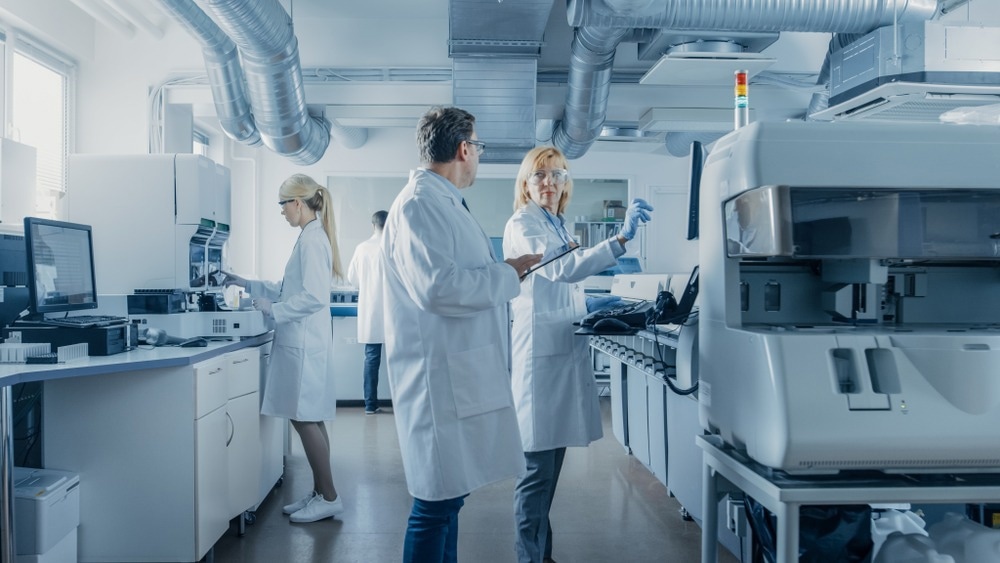Hydrogel electrolytes based on biopolymers have gathered increased attention due to their functionality, low cost, abundance, flexibility, and eco-friendliness. The biopolymers play a role in ion conduction, enabling high electrolytic conductivity, mechanical robustness, and thermal stability, in addition to biodegradability.

Image Credit: Gorodenkoff/Shutterstock.com
Biopolymer Electrolytes and their Characteristics
The consistently depleting fossil-based resources and the associated climate and environmental issues arising due to their consumption have prompted research on clean and sustainable energy sources and related technologies. Hence, there is a compelling need for the development of energy storage devices such as supercapacitors (SCs) and battery materials. SCs act as energy storage devices providing longer cycling life along with higher power density than batteries. They also have greater energy density compared to conventional capacitors.
SCs require modified electrode construction to achieve high energy densities. The electrolyte plays an important role in conversion devices as well as electrochemical energy storage that facilitates ionic transportation among the two electrodes. Polymer hydrogel electrolytes are primarily constituted by polymer networks and conductive salt in a dissolved state in the solvent.
Hydrogel electrolytes can be advantageous in overcoming the limited area of contact between the solid-state electrolyte and the electrode material. This is accompanied by high ionic mobility and conductivity as with liquid electrolytes.
However, most hydrogel electrolytes are sourced from fossil fuels, and the waste generated from their production leads to environmental pollution and demands an urgent development of renewable materials for energy storage applications.
Furthermore, biopolymers such as chitosan, cellulose, alginate, lignin, and chitin have been studied to synthesize operational hydrogel electrolytes. The existence of hydrophilic -COOH, -OH, CONH2, and –NH2 groups in the biopolymer structures exhibits a strong ability for preferential interactions with salt anions, subsequently aiding characteristic cation transport and salinity solubility.
Biopolymer-based hydrogels are usually fabricated through the physical cross-linking of polymer chains that involve the interactions of ionic and hydrogen bonds, followed by the formation of novel covalent bonds through chemical cross-linking. Although they are environmentally friendly and non-toxic, biopolymer hydrogels are characterized by poor mechanical strength that results in weak interface bonding, potential reduction in electrochemical performance under mechanically strained conditions, and inadequate cross-linking. Thus, the electrochemical performance of energy storage devices utilizing biopolymer-based hydrogel electrolytes is severely limited.
Applications of Biopolymer-Based Hydrogel Electrolytes
Hydrogel electrolytes based on biopolymers can thus be effectively modified by inorganic filler-doping, blending, and grafting to improve their mechanical strength compared to conventional electrolytes. The ionic conductivity can be improved even further by co-block polymerization or by mixing the polymer monomers that reduce the biopolymer crystallinity along with improved ductility and toughness.
SCs are classified into pseudo capacitors and double-layer capacitors based on their mechanisms of charge storage. The coupling of redox and carbon-based materials can enable the fabrication of hybrid SCs, combining the two electrodes’ potential window that widens the device’s overall voltage and thereby increases the SC’s energy density.
One area that has received the attention of polymer hydrogel electrolytes is wearable electronics. Moreover, the tunable mechanical characteristics, biocompatibility, ionic conductivity, and simple fabrication along with stretchability and adaptation to complex working environments have helped biopolymer-based hydrogel electrolytes to provide various possibilities in flexible electronics.
Recent Studies
Recent advancements to develop SCs containing biopolymer-based hydrogel electrolytes include the use of chitosan, cellulose, alginate, lignin, gelatin, and agarose. In a recent study, researchers prepared a gel electrolyte based on NaCl-agarose that exhibited a high specific capacitance rising to 286.9 F g-1. Another study involved the synthesis of a flexible SC that used carbon cloth electrodes deposited with polyaniline (PANI) and an electrolyte made up of double-crosslinked lignin hydrogen showed a specific capacitance of 190 F g-1 with additional flexibility.
Furthermore, research considering the fabrication of energy storage devices that can be compressed, stretched, and twisted resulted in an SC that comprised of hydrogel electrolytes and electrodes with a dual-network matrix of a hydrogel of polyacrylamide/sodium alginate (PAM/SA) that was reversibly deformable. The electrolyte exhibited a strong bond with the electrode, enhanced electrochemical capacitance, and unimpaired performance after repetitive stretching cycles.
In another study, a polyacrylamide-chitosan-based (PACH/SiO2) water-in-salt electrolyte (HiSE) was prepared. The HiSE was determined to be effective in enhancing the Li-ion batteries indicated by the wider electrochemical window and higher ionic conductivity.
Future Scope
The use of natural biopolymers as a primary component remains a challenge since it is important to maintain the interplay balance among the conductive additives and biopolymer moieties, which further influences the biodegradability and electrochemical performance. It is also crucial for scientists to focus on cost-effective, reproducible, and scalable methodologies for biopolymer extraction using collagen, chitin, chitosan, and others. Moreover, Li-ion batteries with water-sensitive applications would necessitate the development of biohydrogel electrolytes that are capable of inhibiting the decomposition effect of water.
More from AZoM: The Use of AI in Chemical Processes
References and Further Reading
Akshaya Raghavan, Sutapa Ghosh, Recent Advancements on Biopolymer-Based Flexible Electrolytes for Next-Gen Supercaps and Batteries: A Brief Sketch, Chemistry Europe, 2021
Rafael J. Silva , Vanessa Klobukoski , Jessica I.S. de Paula , Izabel C. Riegel-Vidotti , Marcio Vidotti , Assembly of symmetric supercapacitor based on alginate hydrogel electrolyte and polyaniline modified electrodes, Electrochimica Acta (2022), doi: https://doi.org/10.1016/j.electacta.2022.140914
Ting Xu, et al., Biopolymer-based hydrogel electrolytes for advanced energy storage/conversion devices: Properties, applications, and perspectives, Energy Storage Materials, Volume 48, 2022, Pages 244-262, ISSN 2405-8297, https://doi.org/10.1016/j.ensm.2022.03.013
Disclaimer: The views expressed here are those of the author expressed in their private capacity and do not necessarily represent the views of AZoM.com Limited T/A AZoNetwork the owner and operator of this website. This disclaimer forms part of the Terms and conditions of use of this website.